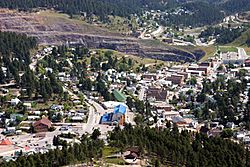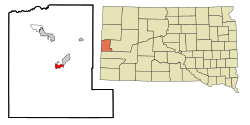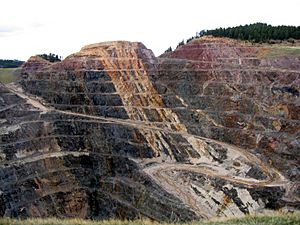Lead, South Dakota facts for kids
Quick facts for kids
Lead, South Dakota
|
|||||||||||||||||||
|---|---|---|---|---|---|---|---|---|---|---|---|---|---|---|---|---|---|---|---|

Aerial photo of Lead in 2004
|
|||||||||||||||||||

Location in Lawrence County and the state of South Dakota
|
|||||||||||||||||||
| Country | United States | ||||||||||||||||||
| State | South Dakota | ||||||||||||||||||
| County | Lawrence | ||||||||||||||||||
| Incorporated | 1890 | ||||||||||||||||||
| Area | |||||||||||||||||||
| • Total | 2.06 sq mi (5.33 km2) | ||||||||||||||||||
| • Land | 2.06 sq mi (5.33 km2) | ||||||||||||||||||
| • Water | 0.00 sq mi (0.00 km2) | ||||||||||||||||||
| Elevation | 5,296 ft (1,614 m) | ||||||||||||||||||
| Population
(2020)
|
|||||||||||||||||||
| • Total | 2,982 | ||||||||||||||||||
| • Density | 1,448.98/sq mi (559.35/km2) | ||||||||||||||||||
| Time zone | UTC−7 (Mountain (MST)) | ||||||||||||||||||
| • Summer (DST) | UTC−6 (MDT) | ||||||||||||||||||
| ZIP code |
57754
|
||||||||||||||||||
| Area code(s) | 605 | ||||||||||||||||||
| FIPS code | 46-36220 | ||||||||||||||||||
| GNIS feature ID | 1267455 | ||||||||||||||||||
|
|||||||||||||||||||
Lead (pronounced LEED) is a city in Lawrence County, South Dakota, United States. It is located in the Black Hills of western South Dakota, close to the Wyoming state line. In 2020, about 2,982 people lived there.
Contents
History of Lead
The city of Lead was officially started on July 10, 1876. This happened after people discovered a lot of gold in the area. The city got its name from the "leads" or "lodes" of valuable metal deposits found underground.
Lead is home to the Homestake Mine. This was once the biggest and deepest gold mine in the Western Hemisphere. It reached a depth of about 8,240 feet (2,512 meters) before it closed in 2002. By 1910, Lead had grown to be the second-largest town in South Dakota.
Lead was built as a "company town" by the Homestake Mining Company. This company owned and operated the Homestake Mine. Phoebe Hearst, whose husband George Hearst was one of the mine's owners, helped make Lead a better place to live. She started the Hearst Free Public Library and the Hearst Free Kindergarten in 1900. Phoebe Hearst also worked with Thomas Grier, the mine's superintendent, to create the Homestake Opera House and Recreation Center. This center was for the miners and their families to enjoy. She also gave money to churches in Lead and offered college scholarships to children of mine workers.
In the early 1930s, people worried that the many tunnels under the Homestake Mine might collapse. Because of this, many buildings in the lower part of the canyon were moved uphill to safer spots.
Today, Lead and the Homestake Mine are home to the Sanford Underground Research Facility, also called Sanford Lab. This special lab is used for science experiments deep underground. Scientists study tiny particles like neutrinos and dark matter. They also do research on biology and mine engineering.
In 1974, most of Lead was added to the National Register of Historic Places. This means it's a special place with important history. The "Lead Historic District" includes over 400 buildings and covers about 580 acres (235 hectares).
Geography of Lead
Lead covers an area of about 2.06 square miles (5.33 square kilometers), and all of it is land.
Two big features in Lead were made by people. One is the huge open pit, which was used for mining gold from the surface. The other is a large hill nearby, made from the rock and dirt that was dug out of the mine.
Climate and Weather
Lead has a climate with warm summers and cold, very snowy winters. The temperatures can change a lot, which is common in the western Great Plains.
Because Lead is high up in the Black Hills, it gets a lot of rain and snow. It's one of the wettest places in South Dakota and one of the snowiest places in the United States. On average, it gets about 184 inches (4.67 meters) of snow each year! In the winter of 1993–94, a huge 365 inches (9.27 meters) of snow fell.
Even with all that snow, much of it melts during the winter. This is because of warm winds called chinook winds. The deepest snow ever recorded on the ground was 73 inches (1.85 meters) in March 1998.
Winters can be very cold, with temperatures sometimes dropping to 0°F (-18°C) or even lower. The coldest temperature ever recorded was -40°F (-40°C) in 1936. However, some winter afternoons can also be quite warm, reaching 50°F (10°C) or more.
Spring weather changes a lot, with frequent storms. Summers are warm in the afternoon, but mornings are usually cool and pleasant. It has even snowed in August before! The hottest temperature ever recorded was 101°F (38°C) in July 1936.
Population in Lead
| Historical population | |||
|---|---|---|---|
| Census | Pop. | %± | |
| 1880 | 1,487 | — | |
| 1890 | 2,581 | 73.6% | |
| 1900 | 6,210 | 140.6% | |
| 1910 | 8,392 | 35.1% | |
| 1920 | 5,013 | −40.3% | |
| 1930 | 5,733 | 14.4% | |
| 1940 | 7,520 | 31.2% | |
| 1950 | 6,422 | −14.6% | |
| 1960 | 6,211 | −3.3% | |
| 1970 | 5,420 | −12.7% | |
| 1980 | 4,330 | −20.1% | |
| 1990 | 3,632 | −16.1% | |
| 2000 | 3,027 | −16.7% | |
| 2010 | 3,124 | 3.2% | |
| 2020 | 2,982 | −4.5% | |
| U.S. Decennial Census 2015 Estimate |
|||
In 2010, there were 3,124 people living in Lead. About 94.6% of the people were White. The average age of people in Lead was 40.5 years old.
Fun Things to Do
Lead offers many outdoor activities, especially in the summer.
- You can find many trails for hiking, mountain biking, and horseback riding.
- The George S. Mickelson Trail passes through the city. This trail goes all the way from Edgemont to Deadwood.
- Several man-made lakes, like Sheridan Lake, are great for fishing and swimming.
- Spearfish Canyon to the north has many places for rock climbing.
Schools
Lead is part of the Lead-Deadwood School District 40-1.
Local Media
|
AM radio stations
|
FM radio stations
|
Television channels |
Famous People From Lead
- Richard Bullock (1847–1921), an American pioneer.
- Sean Covel (born 1976), a film producer.
- James B. Dunn (1927–2016), a South Dakota lawmaker.
- Thomas D. Edwards, a Consul General for the United States.
- Stan Gibilisco, a writer.
- Cynthia Larive, a chemist and Chancellor at the University of California, Santa Cruz.
- John Miljan (1892–1960), an actor.
- Charles Moyer (1866–1929), a labor leader.
- William H. Parker (1905–1966), a former police chief in Los Angeles.
- Len Rice (1918–1992), a baseball player.
- Mina P. Shaughnessy (1924–1978), a professor and scholar.
- Grace M. Sparkes (1893-1963), a community promoter.
- Mike Steponovich (1908–1974), a football player.
- Charles Windolph (1851–1950), a Medal of Honor winner.
See also
 In Spanish: Lead (Dakota del Sur) para niños
In Spanish: Lead (Dakota del Sur) para niños




